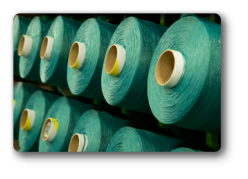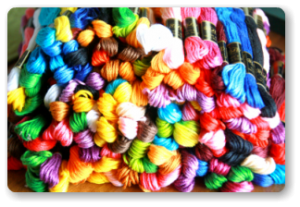Wastewater Sources by Stages in Textile Production Process
 No one would deny that our environment provides space to live, offer resources to thrive and act as sink to help assimilate all types of generated waste. Owing to the advancement of science and technology we as human beings create different types of industries for our basic needs and for sophisticated living. As a result of this what looms large is pollution of our environment which we cannot continue to do as it is finite and fast depleting too. Water pollution is very alarming because we cannot live without water even though 70% of earth’s surface is covered with water (only a fraction of this percentage is good quality water).
No one would deny that our environment provides space to live, offer resources to thrive and act as sink to help assimilate all types of generated waste. Owing to the advancement of science and technology we as human beings create different types of industries for our basic needs and for sophisticated living. As a result of this what looms large is pollution of our environment which we cannot continue to do as it is finite and fast depleting too. Water pollution is very alarming because we cannot live without water even though 70% of earth’s surface is covered with water (only a fraction of this percentage is good quality water).
Textile industry generates a large amount of effluent water which have to be treated before it becomes safe water for further use or release. Textile production processes such as Pre-treatment, dyeing, printing, and finishing generate large amount of textile wastewater that needs careful treatment according to its size and the chemical and biological load.
Desizing
While weaving yarn into fabric, the warp is coated with sizing agents to strengthen the yarn to reduce breaking of yarn in the loom. Before the dyeing, printing and finishing it is necessary to remove these added sizes which is called as desizing which help improve the absorption percentage of dyes and pigments.
Traditonally, desizing is done by using bulk chemicals such as acids, caustic soda, detergents or bacterial material. Recent advancements in Science have brought forth enzymatic desizing which has many advantages:
- No damage to the fibre
- No use of harmful chemicals
- Wide variety of application
- Allows the use of optical brighteners
- High biodegradability
Scouring
 Scouring is a process through which the hydrophobic character of the fiber is eliminated by removing the presence of natural impurities like oil, wax, gum, fat and any other impurities that might have added during the fabrication process. At present, Scouring is done through a Continuous Process using a J-Box and a Discontinuous Process using Kier Boiler, Jigger or Winch dyeing machine. Chemicals used in scouring are Caustic (NaOH), Sodium Silicate, Surfactant, Detergent, Sequestering Agent, Builder Salts, Solvents.
Scouring is a process through which the hydrophobic character of the fiber is eliminated by removing the presence of natural impurities like oil, wax, gum, fat and any other impurities that might have added during the fabrication process. At present, Scouring is done through a Continuous Process using a J-Box and a Discontinuous Process using Kier Boiler, Jigger or Winch dyeing machine. Chemicals used in scouring are Caustic (NaOH), Sodium Silicate, Surfactant, Detergent, Sequestering Agent, Builder Salts, Solvents.
It is to be noted that the processes of Desizing and Scouring alone contributes to approximately 50% of BOD in the wastewater generated during the textile wet process.
Dyeing
Dyeing is a process in which color is applied to a material like fibre, yarns and finished textile. Two types of dyes are used: natural dyes and synthetic dyes. If we do a quick run of what type of chemicals/metals go into dyeing as a process, we would be left with the following list that is not all inclusive: acids, mordants/dye fixative (normally a polyvalent metal iron, often chromium, tannic acid, alum, chrome alum, sodium chloride, salts of aluminium, chromium, iodine, potassium, tungsten, tin, sodium, iron, etc, ), Cationic agents, sodium or potassium bichromate, phenols, B-naphthols, aniline, coal-tar derivatives, etc.
Dyeing contributes to the major portion of the textile wastewater.
The following table captures the pollutants and its chemical types by each process step.
TABLE 1: Pollutants and its Chemical Types by Process Step
| No. | PROCESS STEP | CHEMICAL TYPE | POLLUTANTS |
|---|---|---|---|
| 1 | Desizing, bleaching, dyeing | Starches, enzymes, fats, greases, waxes, surfactants, acetic acid | Organic load |
| 2 | Dyeing | Dyes, scoured wool impurities | Color |
| 3 | Dyeing | Ammonium salts, urea phosphate based buffers, and sequestrants | Nutrients (N and P) |
| 4 | Scouring, desizing, bleaching, mercerizing, dyeing | NaOH, mineral/organic acids, sodium chloride, silicate, sulfate, carbonate | pH and salt effects |
| 5 | Dyeing | Sulfate, sulfide, hydrosulfite salts, and sulfuric acid | Sulfur |
| 6 | Desizing, bleaching, dyeing, finishing | Heavy metals, reducing agents (e.g., sulfide), oxidizing agents (e.g., chlorite, peroxide, dichromate, and persulfate), biocides, quaternary, ammonium salts | Toxicants |
| 7 | Bleaching, desizing, dyeing, finishing | Surfactants, dyes, resins, synthetic sizes (e.g., PVA), chlorinated organic compounds, carrier organic solvents | Refractory organics |
The total wastewater from a typical textile unit has a big load of chemicals, biological agents, and minerals. The effluent composition is captured in Table 2.
TABLE 2: Textile Wastewater Composition by Process
| No. | Nature of Textile Wastewater | Process | Textile Wastewater Composition |
|---|---|---|---|
| 1 | High in BOD, COD | Sizing | Starch, waxes, carboxymethyl cellulose (CMC), polyvinyl alcohol (PVA), wetting agents |
| 2 | High in BOD, COD, SS, DS | Desizing | Starch, CMC, PVA, fats, waxes, pectin |
| 3 | High alkalinity, high SS (suspended solid) | Bleaching | Sodium hypochlorite, Cl2, NaOH, H2O2, acids, surfactant, NaSiO3, sodium phosphate, cotton fiber |
| 4 | High pH, low BOD, high DS | Mercerizing | Sodium hydroxide, cotton wax |
| 5 | Strong colored, high BOD, high DS, low SS, low heavy metals | Dyeing | Dyestuffs urea, reducing agents, oxidizing agents, acetic acid, detergents, wetting agents |
| 6 | Highly colored, high BOD, oily appearance, High Suspended Solid, slightly alkaline, low BOD | Printing | Pastes, urea, starches, gums, oils, binders, acids, thickeners, cross-linkers, reducing agents, alkali |
Zero Liquid Discharge
Hence it is required to treat the total textile wastewater by separating the solids, oxidising of organic and oxygen demanding components, neutralizing, removing poisonous substances and disposing of residual matter. Zero Liquid Discharge (ZLD) is a technology through which all desired treatment can be achieved ensuring that even the last drop of water is treated efficiently and effectively thereby reducing the process cost and saving the environment. It is also to be noted that Zero Liquid Discharge is not a readymade formula for all textile units because the framework and implementation of Zero Liquid Discharge technology varies from every textile unit based on its size and production technology and process it deploys.



